Abstract
Exhaust gas recirculation (EGR) can improve the fuel economy of gasoline direct-injection (GDI) engines, but at the same time it will have a significant impact on emissions. In this paper, the effects of low-pressure exhaust gas recirculation (LP-EGR) and its rate on the main gaseous and particulate emission characteristic of a GDI engine were investigated. The results showed that the particle size distribution of the GDI engine presented bimodal peaks in nucleation and accumulation mode, and the nucleation mode particles comprised the vast majority of the total particles. The effect of LP-EGR on emissions depended on the engine conditions. At low and medium speed, the particle emissions increased with the increase in the EGR rate, while at high speed, a reduction in the particle emission was observed. When the engine operated in full load condition, an increase in the EGR rate reduced the particle number (PN) concentration significantly, but increased the particle mass (PM) concentration. In terms of the gaseous emission, the EGR could reduce as much as 80% of the NOx emission; however, the total hydrocarbons (THC) emission presented an increased trend, and the maximum increase reached 23.5%. At low and medium loads, the EGR could reduce the CO emission, but at high load, the CO emission worsened with the EGR.
1. Introduction
Compared with traditional port fuel injection (PFI) gasoline engines, GDI engines directly inject fuel into the combustion chamber of each cylinder to achieve higher fuel economy performance and a higher compression ratio; they can also reduce the tendency to knock and improve the transient response [1]. However, GDI engines produce uneven mixing of oil and gas and fuel wall wetness, resulting in a significant increase in particulate emissions. The emission level of particulate matter of GDI engines is much higher than that of PFI gasoline engines, and the particle size of the particulate matter is smaller, which causes greater harm to the human body [2,3]. Research on GDI engine emissions is currently a topic of great interest.
Exhaust gas recirculation (EGR) is widely used in current engines, mainly to circulate part of the high-temperature exhaust gas in gasoline engines into the cylinder. This reduces pumping loss and improves combustion quality, thereby reducing fuel consumption and the in-cylinder combustion temperature, thus further reducing NOx emissions [4,5].
Jadhav et al. [6] conducted a computational fluid dynamics (CFD) analysis on a 2 L turbocharged four-stroke GDI engine, and compared the CFD results with the existing experimental data. The results show that, under a 1000 r/min full load condition, compared with the engine without EGR, the indicated mean effective pressure (IMEP) of the engine at 5% EGR rate increased by about 2%. Zhu Zhongpan et al. [7] simulated the performance of the Atkinson gasoline engine based on the one-dimensional model under part load conditions of 3000 r/min. Through the improved genetic algorithm, the exhaust gas recirculation rate, intake valve late closing angle, ignition advance angle, air–fuel ratio, and other parameters were optimized and iterated, and the optimal fuel consumption values and corresponding control parameters at different load conditions were obtained. Wang Zhenyuan et al. [8] studied the influence of different EGR temperatures on the combustion characteristics based on a 1.3 T turbocharged gasoline engine. The results show that, under different load conditions of 1500 r/min, with the increase in EGR temperature, the fuel consumption rate exhibited a tendency to increase, the optimal ignition advance angle increased, and the combustion duration increased. After turning off EGR cooling, the EGR temperature rose sharply, and the maximum average effective pressure of the engine reduced by 3%. Zhou you et al. [9] studied the effects of EGR rate and ignition timing on spark-assisted compression ignition (SACI) combustion and emission performance based on a modified gasoline spark ignition/compression ignition (SI/CI) engine. The results show that EGR can effectively reduce the pressure rise rate and suppress knocking; it also plays a role in improving fuel economy and NOx emissions. By adjusting the ignition timing within the range of 9°CA–10°CA, the engine can obtain the best torque and brake specific fuel consumption (BSFC).
Takaki [10] studied various cooling EGRs, such as low-pressure EGR and high-pressure EGR, applied to a turbocharged gasoline engine, and found that LP-EGR can provide sufficient EGR at low engine speeds and can better suppress knocking, which can improve fuel economy by 5%. Chao Yuedong [11] compared the fuel economy of HP-EGR and LP-EGR based on a 1.3 L turbocharged PFI gasoline engine. The results show that, under the same EGR rate and temperature as in real vehicles (88 ± 3 °C), LP-EGR has a stronger influence on engine combustion than HP-EGR. Under medium and high loads, especially in the low-speed and high-load regions, HP-EGR has the problem of insufficient EGR rate, which severely limits the improvement of fuel economy, while LP-EGR can better suppress knocking and weakens the fuel enrichment effect. Guillaume et al. [12] compared the effects of LP-EGR and internal gas residual (IGR) on engine performance on a 2 L GDI engine. They found that at 2000 r/min 10 bar, increasing IGR increased the temperature of the compression stroke and increased knock sensitivity. Fuel consumption has a negative effect, and increasing LP-EGR can achieve improved fuel economy. Wang Jinqiu et al. [13] studied the combustion and fuel consumption characteristics under low-pressure EGR based on a 1.0 L turbocharged engine. The results showed that when EGR is used under a heavy load, the sum of the contribution of heat transfer loss and exhaust loss to fuel saving is greater than 90%.
Pan Suozhu et al. [14,15,16,17] studied the effect of changes in EGR rate on the combustion and emission characteristics of GDI engines. Studies show that with the increase in EGR rate, cylinder pressure and temperature gradually decrease; in addition, NOx emissions also gradually decrease, but THC and CO emissions gradually increase. GDI engine exhaust particulate matter presents a bimodal distribution of nucleation mode and accumulation mode particles. When EGR is less than 15%, the particle emissions gradually decrease with the increase in the EGR rate, and the maximum decrease reaches 40%. Zhao Lifeng et al. [18] studied the effects of EGR dilution and lean burn on performance and emissions in a 1.8 L GDI engine. The experimental results show that when EGR dilution is used, NOx emissions are significantly reduced. Yu Xiumin et al. [19] used a gasoline port injection (GPI) + ethanol direct injection (EDI) four-cylinder SI engine to study the effect of EGR on combustion and emissions under the following operating conditions: λ = 1, speed = 1500 rmp, and direct injection time (DIT) = 120°CA. The results show that, with the increase in EGR, NOx continues decreasing, and BSFC, CO, and HC first decrease and then increase.
At present, most research on EGR focuses on the engine combustion process and fuel consumption. There are few studies on nucleation/accumulation mode particles and gaseous matter emissions. Therefore, in order to further improve GDI engine particle and gaseous matter emissions, in this study, we used a four-cylinder, 1.5 L GDI engine to assess the influence of LP-EGR rate on the particle size, number concentration, and mass concentration of nucleation/accumulation mode particles and gaseous emissions under different working conditions.
2. Experimental Methodology
2.1. Test Equipment
The test engine was a 1.5 L gasoline direct-injection exhaust gas turbocharged intercooled engine with four in-line cylinders and four valves, a compression ratio of 11.5, and a rated power and maximum torque of 124 kW and 250 N.m, respectively. The test fuel was commercial No. 95 gasoline. Detailed engine parameters are shown in Table 1.

Table 1.
The specifications of the test engine.
Particulate matter was measured using a EEPS 3090 particle size analyzer, which uses a special charging system and multi-stage electrometer to obtain all particle size signals at the same time. The test size range was 5.6 nm~560 nm, which mainly includes two types of particles: nucleation mode and accumulation mode. Nucleation mode particles generally have a particle size of 3 nm~50 nm and are mainly solid particles formed by condensation nucleation of volatile organic compounds and sulfates during engine combustion. Accumulation mode particles have a particle size of 50~500 nm, and are mainly formed by the adsorption of HC, metal ash, sulfate, and other substances on the surface of soot particles generated by the thermal cracking and dehydrogenation reaction of fuel at high temperatures [20,21,22].
Gaseous emissions were measured using a Horiba MEXA-ONE emission analyzer, CO was measured using an infrared detector, and the CO measurement range was 0–1000 ppm. THC was measured using a flame ionization detector, in a measurement range of 0–500 ppm. NOx was detected by chemiluminescence and the measuring range was 0–10,000 ppm.
The specifications of the test equipment are shown in Table 2.

Table 2.
Test equipment.
2.2. Experimental Setup
In this study, we selected three common engine operating conditions, i.e., 2000 r/min 10 bar, 2000 r/min 15 bar, and 4000 r/min 10 bar, and a special operating condition, i.e., 4000 r/min full load. See Table 3 for the specific test conditions. The layout of the engine test bench is shown in Figure 1. The EGR rate was controlled by adjusting the opening of the EGR valve and the emission analyzer readings. Each operating point was adjusted to 0, 5%, 10%, 15%, 20% to study the influence of EGR rate changes on GDI engine particulate matter and gaseous matter emissions.

Table 3.
Test operating point.
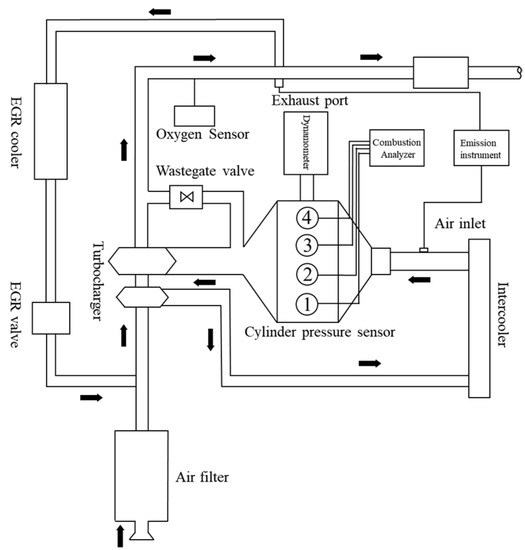
Figure 1.
Engine bench layout.
The EGR rate was calculated by measuring the volume fraction of CO2 in the intake manifold, the exhaust pipe, and the atmospheric environment, using Equation (1) [23].
denotes EGR rate; denotes the volume fraction of CO2 in the intake manifold; denotes the volume fraction of CO2 in the exhaust pipe; and denotes the volume fraction of CO2 in the atmosphere.
3. Results and Discussion
3.1. In-Cylinder Combustion Characteristics
CA50 is defined as the crankshaft angle corresponding to the cumulative heat release rate of 50% [24]. Under a small load, when the engine was calibrated, the CA50 was adjusted to the range close to constant volume combustion. In engineering, 7°CA–9°CA is regarded as the best calibration interval of CA50 [25]. The engine combustion is considered to be most complete within this range.
Figure 2 shows the effect of the EGR rate on CA50. As the EGR rate increased, the CA50 gradually decreased. CA50 was in the optimum calibration range at 4000 r/min 10 bar, when the combustion efficiency in the cylinder was high. At 2000 r/min, CA50 was beyond the optimum calibration interval. At 2000 r/min 10 bar, with the increase of EGR rate, CA50 gradually approached the optimal calibration interval. At 2000 r/min 15 bar, the CA50 was far greater than 9°, indicating that the in-cylinder combustion efficiency was not satisfactory under this working condition.
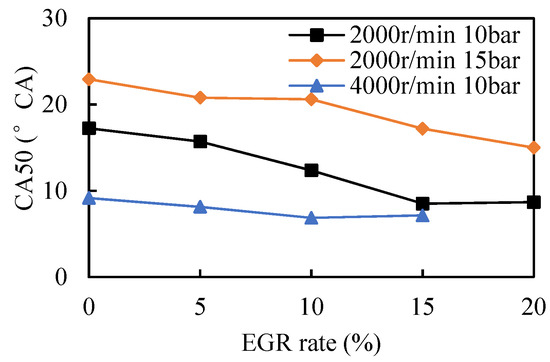
Figure 2.
The effect of EGR rate on CA50.
As shown in Figure 3, as the EGR rate increased, the CA1090 (also known as combustion duration) increased. CA1090 is defined as the crankshaft angle range from 10% to 90% of the cumulative heat release rate [24]. As a result of the increase in EGR, the amount of exhaust gas in the cylinder increased, which diluted the fuel mixture, reduced the flame propagation speed, and slowed down the combustion, thereby prolonging the heat release process.
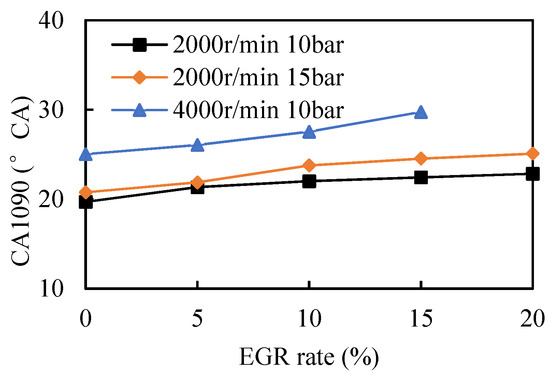
Figure 3.
Influence of EGR rate on combustion duration.
As shown in Figure 4, the exhaust gas temperature gradually decreased as the EGR rate increased. The main reason is that the increase in EGR rate increased the dilution effect of the in-cylinder mixture, which inhibited combustion and slowed down the heat release process, which led to a decrease in the temperature in the cylinder [14] and a decrease in the exhaust gas temperature.
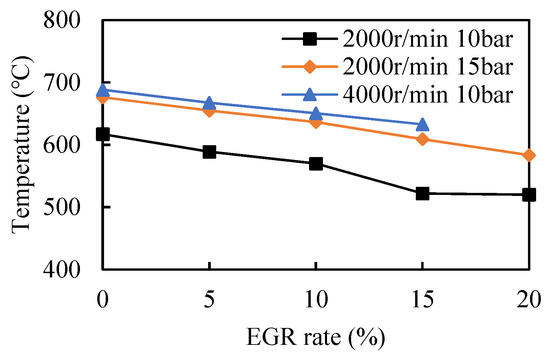
Figure 4.
The exhaust gas temperature changes with the increase in EGR rate.
3.2. Particle Size Distribution
Figure 5 shows the distribution characteristics of the particle size of a gasoline engine at 2000 r/min 10 bar, 2000 r/min 15 bar, and 4000 r/min 10 bar as the EGR rate changed. Under the test conditions, GDI engine exhaust particles exhibit a bimodal distribution of nucleation and accumulation.
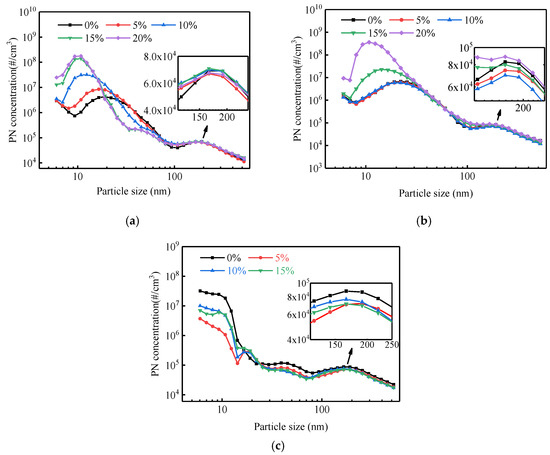
Figure 5.
Distribution characteristics of particle size with EGR rate. (a) 2000 r/min 10 bar; (b) 2000 r/min 15 bar; (c) 4000 r/min 10 bar.
As shown in Figure 5a,b, at 2000 r/min, the peak concentration of accumulation mode particles with the increase in EGR rate first exhibits a decreasing trend and then an increasing trend. As shown in Figure 5c, the peak concentration of accumulation mode particles at 4000 r/min decreased with the increase in EGR rate. The peak particle size of the accumulation mode particles did not change significantly with the increase in the EGR rate, and basically remained at about 160 nm.
GDI engines use direct fuel injection to mix oil and gas, which shortens the mixing time of the oil and gas in the cylinder, resulting in the wet-wall phenomenon, local over-concentration of the fuel, and incomplete combustion in the cylinder [2,3]. The fuel undergoes thermal cracking and a dehydrogenation reaction at high temperatures, which generates soot particles. The surface of the soot particles adsorbs HC, metal ash, sulfate, and other substances to form accumulation mode particle. After the engine introduces exhaust gas, the intake air temperature in the cylinder is increased, and the mixing state of the oil and gas in the cylinder is improved, which is conducive to more complete combustion of the fuel. In addition, with the increase in the EGR rate, the dilution effect on the in-cylinder mixture is enhanced, the combustion is inhibited, and the heat release process becomes slower, resulting in a decrease in the temperature in the cylinder [11] and weakened thermal cracking and dehydrogenation of the fuel in the cylinder. The reaction suppresses the generation of primary soot particles. Therefore, at 4000 r/min, the peak concentration of accumulation mode particle decreases with the increase in EGR rate. However, as the EGR rate continues to increase, as the exhaust gas increases, the mixture is diluted and the oxygen concentration in the cylinder decreases, which inhibits combustion in the cylinder and increases the number of primary soot particles. Under the combined effect, the generation of primary soot particles may first decrease and then increase, leading to the decrease and then subsequent increase in the peak concentration of accumulated particles at 2000 r/min.
As shown in Figure 5a,b, when the load is 2000 r/min 10 bar and 2000 r/min 15 bar, the peak number concentration of nuclear particles gradually increased with the increase in the EGR rate. The peak particle size decreased with the increase in EGR. Nucleation mode particles are mainly formed by the nucleation of HC compounds and sulfates during the combustion process of the engine [21]. As the EGR rate increases, the HC volume fraction gradually increases [14], which enhances the nucleation probability and adsorption of HC compounds, increases the generation of nuclear particles, and leads to a gradual increase in the peak particle number concentration.
As shown in Figure 5c, at 4000 r/min 10 bar, the peak number concentration of nuclear particulates first exhibits a decreasing trend and then an increasing trend with the increase in the EGR rate. This is mainly because the combustion temperature in the cylinder increased during the expansion stroke, which enhanced the oxidation effect of nuclear particles, but the increase in the EGR rate increased the nucleation probability and adsorption of HC compounds [14]. The combination of the two leads to the tendency of the peak number concentration of nuclear particles to first decrease and then increase.
Figure 6 shows the distribution characteristics of particle size with EGR rate under a full load of 4000 r/min. After adding EGR, the peak number concentration of nuclear particulates was greatly reduced, and the greater the EGR rate, the smaller the peak number concentration. The main reason was that EGR suppresses the “over-injection” phenomenon of GDI engines and reduces the enrichment of the mixture [25]. With the increase in the EGR rate, the peak number concentration of the accumulated particulate matter increased, and the peak particle size was basically maintained at about 80 nm.
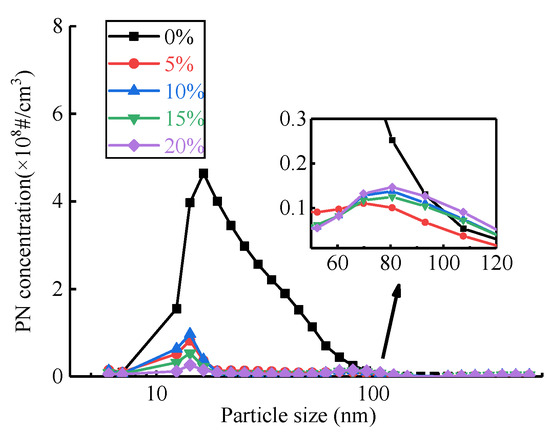
Figure 6.
Particle size distribution characteristics under different EGR rates at 4000 r/min full load.
3.3. Concentration of Particulate Number (PN)
As shown in Figure 7, it was demonstrated that the concentration of nucleation and accumulation mode particle changes with the EGR rate under different loads.
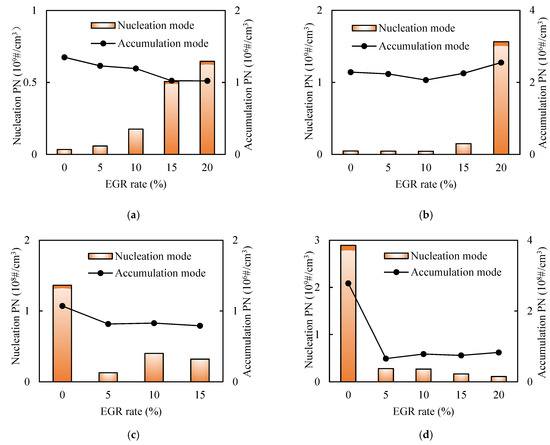
Figure 7.
The number concentration of nucleation and accumulation mode particles varies with EGR. (a) 2000 r/min 10 bar; (b) 2000 r/min 15 bar; (c) 4000 r/min 10 bar; (d) 4000 r/min full load.
As shown in Figure 7a,b, at 2000 r/min 10 bar and 2000 r/min 15 bar, the concentration of nuclear particles increased with the increase in the EGR rate. With the increase in the EGR rate, the concentration of exhaust gas in the cylinder increased, which reduced the oxygen concentration. Moreover, the combustion temperature in the cylinder also decreased, which was conducive to the generation of HC and led to an increase in HC emissions [6]. The increase in HC volume fraction enhanced the nucleation probability and adsorption of HC compounds, and gradually increased the generation of nuclear particles.
As shown in Figure 7c,d, under 4000 r/min 10 bar and 4000 r/min full load, the concentration of nuclear particles decreased with the increase in the EGR rate.
On the one hand, the engine speed increased and the airflow movement in the cylinder increased, which helped to improve the combustion in the cylinder and reduce particulate matter emissions. On the other hand, the increase in EGR rate prolonged the heat release process. The combustion temperature in the stroke cylinder increased, the oxidation of nuclear particles was enhanced, and the emission of nuclear particles was reduced [6].
Except for 2000 r/min 15 bar, the concentration of accumulation mode particles under all working conditions decreased with the increase in the EGR rate. After adding EGR to the GDI engine, the intake air temperature increased and the mixing state of the oil and gas in the cylinder improved, making combustion more complete, and reducing the generation of primary soot particles. Moreover, after the introduction of waste, the combustion temperature in the cylinder reduced, and the combustion temperature was weakened. The thermal cracking and dehydrogenation reaction of the fuel in the cylinder further inhibited the formation of primary soot particles [8]. Under the combined action of the two, the amount of accumulation mode particles gradually decreased with the increase in the EGR rate. However, as the EGR rate increased, the increase in exhaust gas in the cylinder diluted the mixture, resulting in a decrease in the oxygen concentration. Furthermore, under a heavy load, the amount of fuel injected into the cylinder increased, resulting in incomplete combustion, which resulted in 2000 r/min 15 bar at a 20% EGR rate. The number and concentration of accumulation mode particles increased.
As shown in Figure 8, except for the 4000 r/min full load condition, the nuclear particle number concentration accounted for more than 90% of the total number of PNs under other conditions, i.e., the vast majority of the particle number concentration. Under 4000 r/min full load, with the increase in the EGR rate, the proportion of the nucleation mode particle concentration gradually decreased, mainly because EGR suppresses over-injection.
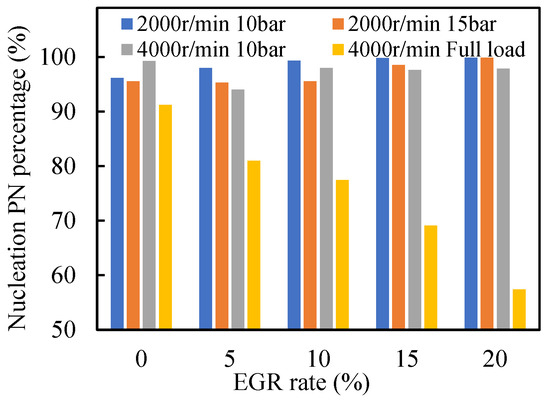
Figure 8.
The percentage of nuclear particles.
Figure 9 shows the distribution characteristics of the total PN concentration with the change in the EGR rate under different working conditions of the GDI engine. At 2000 r/min, with the increase in the EGR rate, the PN concentration of the GDI engine increased significantly. This is mainly because the number of nuclear particles accounted for the vast majority of the total number of particles, as shown in Figure 8, and the change trend of the number concentration of nuclear particles with the EGR rate became the dominant factor in the total number of particles with the EGR rate. Therefore, the change in PN concentration with the EGR rate was consistent with the law of nuclear particle number concentration with EGR rate.
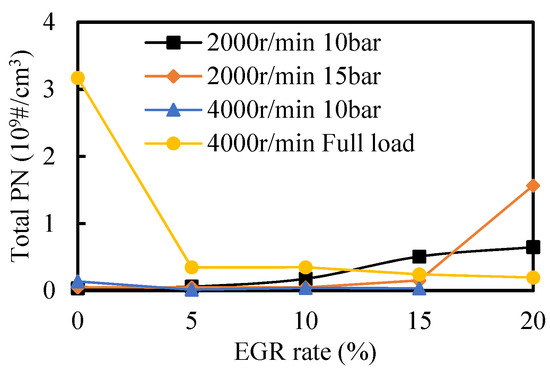
Figure 9.
The effect of EGR rate on the concentration of particulate matter.
At 4000 r/min, the PN concentration decreased with the increase in the EGR rate. At 4000 r/min and full load, the PN concentration sharply decreased after adding EGR. The main reason is that EGR suppresses the “over-injection” phenomenon, reduces the mixture enrichment, and greatly reduces the PN concentration. It can be seen that at high speeds, increasing the EGR rate can reduce PN emissions.
3.4. Concentration of Particulate Mass (PM)
As shown in Figure 10, it was demonstrated that the mass concentration of nucleation and accumulation mode particle changes with EGR under different working conditions. At 2000 r/min 10 bar and 2000 r/min 15 bar, the mass concentration of nuclear particles increased with the increase in the EGR rate. At 4000 r/min 10 bar and 4000 r/min full load, the mass concentration of nucleation mode particles exhibited a decreasing trend with the increase in the EGR rate. The change trend of the mass concentration of nuclear particles was consistent with the change trend of the number concentration. The main reason is that the nuclear particle size is small, and the range of peak particle size varies little under different EGR rates. Therefore, the quantity change is the leading factor in the increase in the mass of nuclear particles.
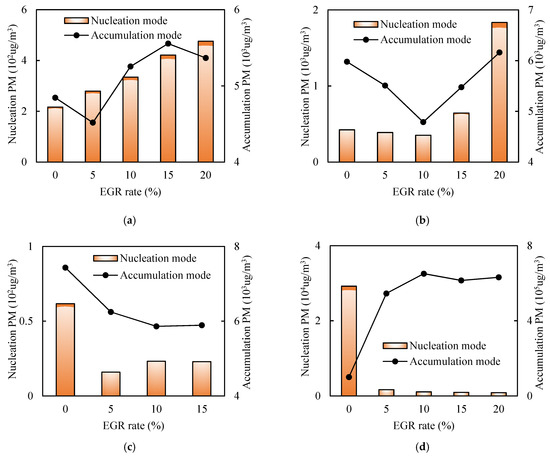
Figure 10.
The law of nuclear and accumulated particle mass concentration changes with EGR. (a) 2000 r/min 10 bar; (b) 2000 r/min 15 bar; (c) 4000 r/min 10 bar; (d) 4000 r/min full load.
At 2000 r/min 10 bar and 2000 r/min 15 bar, the mass concentration of accumulation mode particles firstly decreases and then increases with the rate of EGR, which is consistent with the change in the peak number concentration of accumulation mode particles under this working condition.
At 4000 r/min 10 bar, the mass concentration of accumulation mode particles decreased with the increase in the EGR rate. This is consistent with the change law of the number concentration and the peak number concentration. Moreover, the peak particle size is basically unchanged under this working condition.
At a full load of 4000 r/min, the mass concentration of accumulation mode particles increased with the increase in the EGR rate. After adding EGR, the number concentration of accumulation mode particles dropped sharply, while the particle size increased, resulting in an increase in the mass concentration.
As shown in Figure 11, as the EGR rate increased, the total PM concentration did not greatly change. Under the full load of 4000 r/min, the total PM concentration increased after adding EGR. As EGR continued to increase, the PM concentration basically remained unchanged. Moreover, in general, after adding EGR, the number of large-size particles increased.
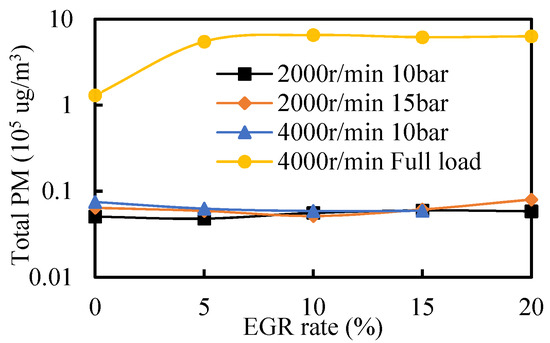
Figure 11.
The effect of EGR rate on the mass concentration of particulate matter.
3.5. Gaseous Emission Characteristics
Figure 12 shows the effect of the EGR rate on gaseous emissions. THC emissions increased with the increase in the EGR rate, with a maximum increase of 23.5%. The law of NOx emissions is the opposite, with a maximum decrease of more than 80%.
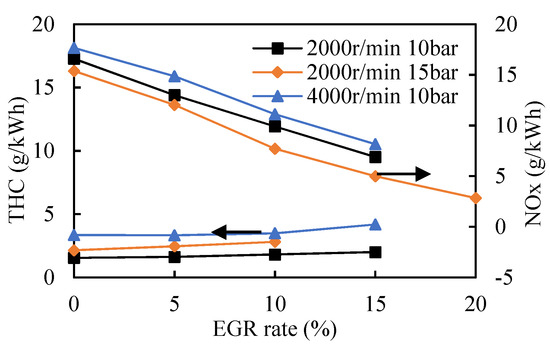
Figure 12.
THC and NOx emission characteristics under different EGR rates.
Increasing the EGR rate slows down the combustion heat release in the cylinder, lowers the temperature in the cylinder, and reduces NOx emissions. Furthermore, the oxygen concentration in the cylinder is reduced, which is conducive to the generation of THC.
As shown in Figure 13, at 2000 r/min 10 bar and 4000 r/min 10 bar, CO specific emissions exhibited a decreasing trend with the increase in the EGR rate, but the decrease was not pronounced. The main reason is that the increase in the EGR rate prolongs the combustion duration, and thus CO has time to fully burn. At 2000 r/min 15 bar, the CO-specific emission increased significantly, mainly because the CA50 was higher than the optimal range at a low speed and high load, and the engine had a greater tendency to knock. In order to suppress knocking, the ignition can be delayed by sacrificing fuel economy. The overall combustion shifts back, reducing the CO oxidation effect in the later stage of the combustion. In addition, the increase in the EGR rate reduces the combustion temperature and oxygen concentration in the cylinder and weakens the CO oxidation effect. Therefore, at low speed and high load conditions, the increase in the EGR rate worsens CO emissions.
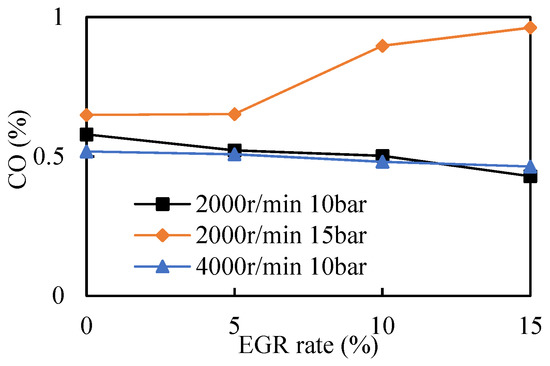
Figure 13.
CO emission characteristics under different EGR rates.
4. Conclusions
This paper studies the effect of LP-EGR rate on emissions from GDI engines at medium and high speeds/loads. It focuses on the analysis of the particle size distribution characteristics, quantity concentration, mass concentration of nuclear and accumulated particles, and the emission characteristics of the main gaseous pollutants. The results are as follows:
- (1)
- As the EGR rate increased, the CA50 gradually decreased, the combustion duration was prolonged, the heat release process was lengthened, and the exhaust temperature was reduced.
- (2)
- GDI engine exhaust particulate matter exhibited a bimodal distribution of nucleation mode and accumulation mode particles. Under partial load conditions, EGR had little effect on the peak particle size of accumulation mode particles. At 2000 r/min, with the increase in the EGR rate, the peak nucleation mode particle concentration gradually increased, and the peak particle size gradually decreased. At 4000 r/min, with the EGR rate increase, the peak number concentration of nuclear particles gradually decreased. Under full load conditions, the addition of EGR greatly reduced the peak number concentration of nuclear particles, and gradually decreased with the increase in the EGR rate. The peak number concentration of accumulated particulates and the peak particle size increased with the increase in the EGR rate.
- (3)
- Nucleation mode particles accounted for the vast majority of the total PN. At 2000 r/min, with the increase in the EGR rate, the number concentration and mass concentration of nuclear particles gradually increased. At 4000 r/min, the number concentration and mass concentration of nuclear particles gradually decreased with the increase in the EGR rate. At a full load of 4000 r/min, after the introduction of EGR, the number concentration of nuclear and accumulated particles was greatly reduced, while the concentration of accumulated particles increased significantly.
- (4)
- At 2000 r/min, the total PN concentration increased with the increase in the EGR rate. At 4000 r/min, the PN concentration decreased with the increase in the EGR rate. The increase in the EGR rate had little effect on the total PM. At a full load of 4000 r/min, adding EGR greatly reduced the total PN, while the total PM increased.
- (5)
- Increasing the EGR rate can greatly reduce NOx emissions, and the maximum reduction can reach more than 80%. However, THC emissions increase by up to 23.5%. When the load is 10 bar, increasing EGR can reduce CO emissions. While at 15 bar, increasing the EGR rate worsens CO emissions.
- (6)
- The research results in this paper provide a reference for reducing the particulate and gaseous emissions of GDI gasoline engines. The suggestions include using different EGR rates under different operating conditions to reduce particulate emissions. In this study, only the steady-state operation of the GDI engine was considered. The next step will be to study the effect of the EGR rate on GDI engine emissions under transient operating conditions.
Author Contributions
Conceptualization, D.L.; L.F. and Y.Z.; methodology, B.W.; software, G.L.; validation, G.L. and B.W.; formal analysis, G.L.; investigation, G.L.; resources, D.L.; data curation, G.L.; writing—original draft preparation, G.L.; writing—review and editing, D.L.; L.F. and Y.Z.; visualization, G.L.; supervision, D.L.; L.F. and Y.Z.; project administration, D.L.; L.F.; funding acquisition, D.L.; L.F. All authors have read and agreed to the published version of the manuscript.
Funding
This research was funded by “National Key Research and Development Program of China”, grant number 2018YFB0105802.
Institutional Review Board Statement
Not applicable.
Informed Consent Statement
Not applicable.
Data Availability Statement
Not applicable.
Conflicts of Interest
The authors declare no conflict of interest.
References
- Fang, T.G.; Wang, L.B.; Wang, Z. Particulate Matter Emissions from Gasoline Direct Injection Engines: Research Review. J. Automot. Saf. Energy 2017, 8, 226–238. [Google Scholar]
- Braisher, M.; Stone, R.; Price, P. Particle Number Emissions from a Range of European Vehicles; SAE World Congress & Exhibition: Detroit, MI, USA, 2010; Volume 1. [Google Scholar]
- Shuai, S.; Dong, Z.; Zheng, R.; Wang, B.; Fu, H.; Xu, H.; Wang, J. Review of formation mechanism and emission characteristics of particulate matter from automotive gasoline engines. Trans. CSICE 2016, 2, 105–116. [Google Scholar]
- Wei, H.; Zhu, T.; Shu, G.; Tan, L.; Wang, Y. Gasoline engine exhaust gas recirculation–A review. Appl. Energy 2012, 99, 534–544. [Google Scholar] [CrossRef]
- Gao, D.D.; Luo, M.J.; Liu, C.; Wang, Y.N.; Qiu, L. Influence of EGR on Emission Characteristics of In-use Gasoline Vehicles. Small Intern. Combust. Engine Veh. Tech. 2020, 49, 1–5. [Google Scholar]
- Jadhav, P.D.; Mallikarjuna, J.M. Effect of EGR on Performance and Emission Characteristics of a GDI Engine-A CFD Study. In Proceedings of the 13th International Conference on Engines & Vehicles, Detroit, MI, USA, 4 September 2017. [Google Scholar]
- Zhu, Z.P.; Lin, R.; Du, A.M. Economy Performance Optimization Algorithm of Exhaust Gas Recirculation Atkinson Gasoline Engine. J. Tongji Univ. (Nat. Sci.) 2018, 46, 848–853, 860. [Google Scholar]
- Wang, Z.Y.; Chao, Y.D.; Li, L.G. Effect of EGR Temperature on Combustion and Performance in small Displacement Turbocharged Gasoline Engine. J. Tongji Univ. (Nat. Sci.) 2017, 45 (Suppl. S1), 152–156. [Google Scholar]
- Zhou, Y.; Hong, W.; Xie, F.X.; Shu, Y.; Liu, Y.; Li, X.P.; Duan, J.Q. Effect of EGR and Ignition on the Performance of Spark-Assisted Compression Ignition Engine Fueled with Gasoline. J. Jilin Univ. (Eng. Technol. Ed.) 2021, 1–10. [Google Scholar]
- Takaki, D.; Tsuchida, H.; Kobara, T.; Akagi, M.; Tsuyuki, T.; Nagamine, M. Study of an EGR System for Downsizing Turbocharged Gasoline Engine to Improve Fuel Economy; SAE Technical Paper; SAE: Detroit, MI, USA, 2014; Volume 1, p. 1199. [Google Scholar]
- Chao, Y.; Lu, H.; Hu, Z.; Deng, J.; Wu, Z.; Li, L.; Shen, Y.; Yuan, S. Comparison of Fuel Economy Improvement by High and Low Pressure EGR System on a Downsized Boosted Gasoline Engine; SAE World Congress Experience: Detroit, MI, USA, 2017; Volume 1, p. 682. [Google Scholar]
- Bourhis, G.; Chauvin, J.; Gautrot, X.; de Francqueville, L. LP EGR and IGR Compromise on a GDI Engine at Middle Load. SAE Int. J. Engines 2013, 6, 67–77. [Google Scholar] [CrossRef]
- Wang, J.Q.; Chao, Y.D.; Zhu, D.H.; Deng, J.; Li, L.G. Effects of different dilution methods on Fuel Consumption for Gasoline Direct Injection Engine under Different Compression Ratio. J. Tongji Univ. (Nat. Sci.) 2019, 47, 1801–1808. [Google Scholar]
- Pan, S.Z.; Song, C.L.; Pei, Y.Q.; Lu, G. Influence of EGR on Combustion and Emissions of a Gasoline Direct-Injection Engine. Trans. CSICE 2012, 30, 749–754. [Google Scholar]
- Zhao, L.; Yu, X.; Qian, D.; Dong, W.; Sun, P.; He, L.; Yang, S. The effects of EGR and ignition timing on emissions of GDI engine. Sci. China Technol. Sci. 2013, 56, 3144–3150. [Google Scholar] [CrossRef]
- Cai, W.Y.; Ma, S.Y.; Wang, Y.R.; Chen, S.C. Influence of LP-EGR on Combustion and Emissions of a Gasoline Direct-Injection Engine Used in Range Extender. Trans. CSICE 2020, 38, 42–48. [Google Scholar]
- Zheng, R. Study on Emission Characteristics of Primary Particles and Formation Potential of Secondary Particles from Gasoline Engines. Master’s Thesis, Tsinghua University, Beijing, China, May 2015. [Google Scholar]
- Zhao, L.F.; Shu, X.Y.; Yu, X.M. Investigation on Performance and Emissions of a GDI Engine with EGR and Lean Burn. Trans. CSICE 2020, 38, 126–132. [Google Scholar]
- Yu, X.; Zhao, Z.; Huang, Y.; Shi, W.; Guo, Z.; Li, Z.; Du, Y.; Jin, Z.; Li, D.; Wang, T. Experimental study on the effects of EGR on combustion and emission of an SI engine with gasoline port injection plus ethanol direct injection. Fuel 2021, 305, 121421. [Google Scholar] [CrossRef]
- Kittelson, D.B.; Watts, W.F.; Johnson, J.P. On-road and laboratory evaluation of combustion aerosols—Part1: Summary of diesel engine results. Aerosol Sci. 2006, 37, 913–930. [Google Scholar] [CrossRef]
- Maricq, M.M. Chemical characterization of particulate emissions from diesel engines: A review. J. Aerosol Sci. 2007, 38, 1079–1118. [Google Scholar] [CrossRef]
- Wong, C.P.; Chan, T.L.; Leung, C.W. Characterisation of diesel exhaust particle number and size distributions using mini-dilution tunnel and ejector–diluter measurement techniques. Atmospheric Environ. 2003, 37, 4435–4446. [Google Scholar] [CrossRef]
- Agarwal, D.; Singh, S.K.; Agarwal, A.K. Effect of Exhaust Gas Recirculation (EGR) on performance, emissions, deposits and durability of a constant speed compression ignition engine. Appl. Energy 2011, 88, 2900–2907. [Google Scholar] [CrossRef]
- Gong, C.; Li, Z.; Yi, L.; Sun, J.; Liu, F. Comparative analysis of various combustion phase control methods in a lean-burn H2/methanol fuel dual-injection engine. Fuel 2020, 262, 116592. [Google Scholar] [CrossRef]
- Fu, H. Research on Low Pressure Exhaust Gas Recirculation of Gasoline Engine in Simulation and Experiment. Master’s Thesis, Chongqing University, Chongqing, China, July 2017. [Google Scholar]
Publisher’s Note: MDPI stays neutral with regard to jurisdictional claims in published maps and institutional affiliations. |
© 2021 by the authors. Licensee MDPI, Basel, Switzerland. This article is an open access article distributed under the terms and conditions of the Creative Commons Attribution (CC BY) license (https://creativecommons.org/licenses/by/4.0/).